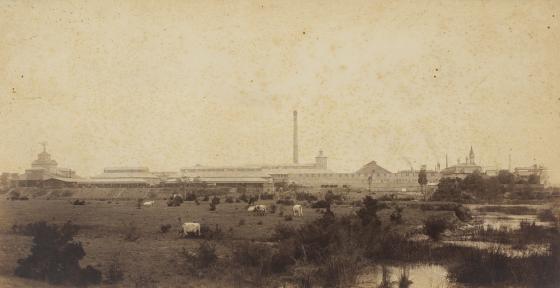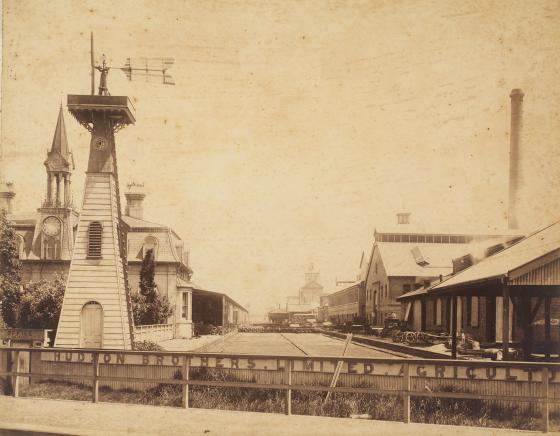
The Library has recently acquired a collection of rare photographic prints of the Hudson Brothers Building Company [PXE 1712]. These were donated by Ruth Farmer whose grandfather, Frederick Farmer worked for Hudson Brothers at the Clyde works.
In the late 1800s, this company was one of the largest manufacturing businesses in Australia and was responsible for building the Garden Palace, as well as many of the country’s early railway carriages.
In 1854, William Henry Hudson was running a small carpentry business from Regent Street, Sydney. The business expanded following a number of important contracts including the building of St. Paul’s Church in Redfern. The company also supplied woodwork for the University of Sydney and St Andrew's Cathedral. In 1866 William Hudson handed over the business to his sons Henry and William, who were later joined by their brother Robert.
Within 25 years, the brothers had turned the small carpentry business into one of Australia's leading manufacturers of iron and timber, employing around 400 men. A turning point for the business was in 1868 when they purchased an old boiler and engine to saw timber. The brothers purchased more machinery to automate their works allowing them to expand into iron and steel.
In January 1876 they were contracted to supply the New South Wales Government with 200 rail wagons and in 1879 they were contracted to build the International Exhibition building in the Botanical Gardens, Sydney. During this period, they became one of the largest buyers of timber in the colonies — processing over 1.8 million metres of timber in 1878 alone. Between 1876-77 Hudson Brothers completed a government contract for two hundred railway wagons at £70 each. Their bush based timber mill incorporated over six miles of railway and several sailing vessels were used to take the wood to Sydney.
The success of the company put pressure on their Redfern site and as their irregular jumble of buildings became increasingly cluttered the brothers started looking further afield for a site to house their growing business.
The Hudson Brothers factory moves West
One Saturday afternoon, in August 1882, 250 ladies and gentlemen lined up along the platform at Redfern Station to board a private train bound for the new Hudson Brothers factory in Western Sydney. They had been invited to witness the laying of the foundation stone for a new factory on the Sydney to Parramatta railway line. This was near a specially built stop on the rail line which was initially called the ‘Hudson Platform’ but was later changed to ‘Clyde Station’.
At the celebrations, Mr John Woods the Victorian Minister for Rail raised his glass to toast the achievements of the Henry Hudson, and his brothers, who had risen from their humble beginnings in Redfern.
Woods predicted that,
within twelve months there would be seen where they were then assembled the most complete establishment in the southern hemisphere, and there would be turned out from that establishment more work with less labour than from any other works of a similar character out of England.

In the 1880s Hudson Brothers included the Redfern and Clyde workshops and sawmills at Pyrmont, Bathurst and the Myall Lakes. In 1884 they employed about 1000 men.
The rapid expansion came at a cost and the company was impacted by the depression of the 1890s. After being unable to secure new railway contracts and experiencing a series of rolling strikes Hudson Brothers was forced into receivership in 1898. The buildings and equipment were purchased by the Clyde Engineering Works who went on to occupy the site.
References
Hudson Brothers New Works, Sydney Morning Herald (NSW: 1842 - 1954), Monday 21 August 1882, page 3
Australian Town and Country Journal (Sydney, NSW: 1870 - 1907), Saturday 15 March 1879, page 22
Hudson Brothers Engineering photographs, ca. 1880-1895, donated by Ruth Farmer in 2016, PXE 1712 http://archival.sl.nsw.gov.au/Details/archive/110587911
Author
Geoff Barker, Senior Curator, Research and Discovery, State Library of New South Wales, 2018
